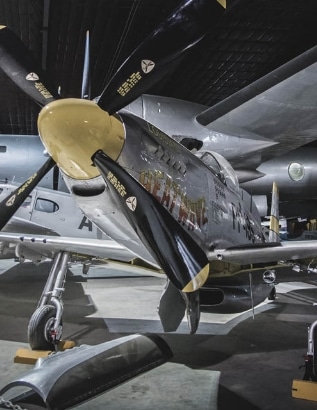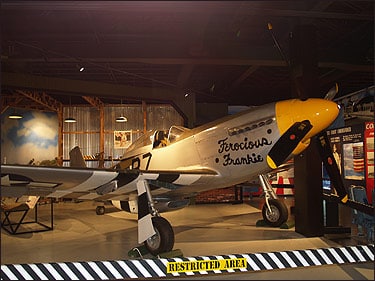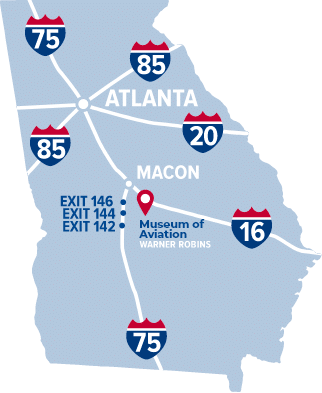The Mustang was among the best and most well-known fighters used by the U.S. Army Air Forces (USAAF) during World War II. Possessing excellent range and maneuverability, the P-51 operated primarily as a long-range escort fighter and also as a ground attack fighter-bomber. The Mustang served in nearly every combat zone during WWII and later fought in the Korean War.
In 1940 the British approached North American Aviation to license-build Curtiss P-40 fighters for the Royal Air Force. North American offered to design a better fighter, which flew as the NA-73X in October 1940. Production of the aircraft, named Mustang I by the British, began the following year.
In the summer of 1941, the USAAF received two Mustangs under the designation XP-51. In March 1942 the USAAF accepted the first production P-51A fighters. Although excellent at lower levels, the P-51A’s Allison engines severely limited performance at high altitude. The USAAF employed P-51As in the China-Burma-India Theater, where most combat took place at low altitude.
In the fall of 1942, Mustangs in the United States and Great Britain were experimentally fitted with British Merlin engines. Mass production of the Merlin-powered P-51B and P-51C soon followed (nearly identical, North American produced the “B” in Inglewood, California and the “C” in Dallas, Texas). In December 1943 the first P-51B/C Mustangs entered combat in Europe.
The P-51D incorporated several improvements, and it became the most numerous variant with nearly 8,000 being built. The P-51D arrived in quantity in Europe in the spring of 1944, becoming the USAAF’s primary long range escort fighter. The versatile Mustang also served as a fighter-bomber and reconnaissance aircraft. Few Luftwaffe aircraft could match the P-51D. By the end of the war, Mustangs had destroyed 4,950 enemy aircraft in the air, more than any other USAAF fighter in Europe.
P-51Ds arrived in the Pacific and CBI theaters by the end of 1944. In the spring of 1945, Iwo Jima-based P-51Ds started flying long range B-29 escort and low-level fighter-bomber missions against ground targets in Japan.
Although Mustangs continued in service with the newly-formed U.S. Air Force and may other nations after the war, more advanced jet fighters relegated them to secondary status. However, after the North Korean army invaded South Korea in June 1950, the Mustang once again proved its usefulness. After the initial invasion, USAF units were forced to fly from bases in Japan, and Mustangs could hit targets in Korea that short-ranged F-80 jet fighters could not. Mustangs continued flying with fighter-bomber units of the USAF and South Korean, South African, and Royal Australian Air Forces on close support and interdiction missions in Korea until they were largely replace by jet fighter-bombers in 1953.
North American eventually developed a considerably lightened Mustang, which became the P-51H. With a remarkable top speed of 487 mph, the P-51H was 50mph faster than the P-51D. Although it was in production before World War II ended, the P-51H did not reach front-line units in time to see combat. With the last of 555 P-51Hs completed in 1946, the production run of the Mustang ended with over 15,000 of all types built.
The Museum of Aviation’s P-51H was delivered to the USAAF in October 1945 and subsequently assigned to Pinecastle Army air Field (AAF), Florida. In June 1946 it was transferred to Chanute AAF, Illinois as a ground instruction air-frame. It continued in this status until May 1949 when it was dropped from the USAF inventory. Subsequently it was placed at various locations around Chanute Air Force Base as a static display until 1993 when the base was closed. It was then transferred to the Chanute Air Museum. When the Museum closed in 2015 it was transferred to the Museum of Aviation.



















